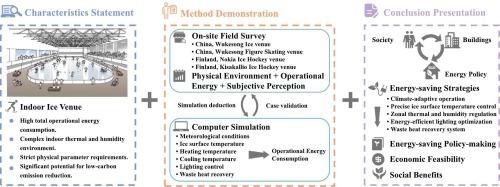中国与芬兰冰上运动场地光热环境与能耗比较
IF 7.1
2区 工程技术
Q1 CONSTRUCTION & BUILDING TECHNOLOGY
引用次数: 0
摘要
由于冰面的冷辐射较强,冰上场馆的室内环境比普通体育设施更为复杂。然而,保持舒适的室内环境需要消耗大量的能源。因此,室内环境质量和能源利用对冰雪场馆的可持续运营至关重要。在双碳议程下,评估现有冰雪场馆的真实运营绩效,寻找节能优化途径迫在眉睫。在中芬政府间科技创新项目的支持下,本研究在中国和芬兰四个具有代表性的冰上场馆进行了实地测量和调查,并采用数值模拟方法对室内环境质量和运营节能措施进行了评价。主要结论:(1)冰区室内气温可以提高到标准上限。在五棵松花样滑冰场地,测量温度(4.7°C)远低于标准温度(12°C)。增加它可以在保持热舒适的同时节省能源。(2)观众区域温度低于标准6-9°C,但可以接受(TSV >; PMV)。下层由于冰面,温度要低2-3°C,需要分区温度控制和增强除湿。(3)照度普遍超标(五棵松花样滑冰场地:1362 lx,标准300 lx)。将设计照度从300lx提高到2000lx将使照明能耗增加约4.3倍。(4)制冰占总能耗的45% ~ 50%。将冰表面温度从- 3°C降低到- 8°C,可以增加8.5 kWh/m2的能耗。提高热回收性能(将COP提高到7.4)可以减少大约15.69千瓦时/平方米的消耗。(5)低碳改造战略可以将芬兰的做法(热回收和季节性操作)与中国的自然采光方法结合起来。本文章由计算机程序翻译,如有差异,请以英文原文为准。

Comparison of light-thermal environment and energy consumption in ice sports venues between China and Finland
Due to strong cold radiation from the ice surface, the indoor environment of ice venues is more complex than that of ordinary sports facilities. However, maintaining a comfortable indoor environment consumes substantial energy. Therefore, indoor environmental quality and energy use are critical to the sustainable operation of ice venues. Under the dual-carbon agenda, it is urgent to assess the real operational performance of existing ice venues and to identify energy-saving optimization pathways. Supported by a China–Finland intergovernmental science and technology innovation project, this study conducted field measurements and surveys at four representative ice venues in China and Finland, and used numerical simulation to evaluate indoor environmental quality and operational energy-saving measures.
Main conclusions: (1) The indoor air temperature in ice areas can be raised to the standard upper limit. At Wukesong Figure skating venue, the measured temperature (4.7 °C) is well below the standard (12 °C). Increasing it would save energy while maintaining thermal comfort. (2) Spectator areas are 6–9 °C below standard but acceptable (TSV > PMV). The lower tier is 2–3 °C cooler because of the ice surface, requiring zoned temperature control and enhanced dehumidification. (3) Illuminance generally exceeds the standard (Wukesong Figure skating venue: 1362 lx vs. standard 300 lx). Increasing design illuminance from 300 lx to 2000 lx would raise lighting energy use by about 4.3 times. (4) Ice production accounts for 45 %–50 % of total energy consumption. Reducing the ice-surface temperature from −3 °C to −8 °C increases energy use by 8.5 kWh/m2. Improving heat-recovery performance (increasing COP to 7.4) can reduce consumption by roughly 15.69 kWh/m2. (5) Low-carbon retrofit strategies could combine Finnish practices (heat recovery and seasonal operation) with Chinese approaches to natural daylighting.
求助全文
通过发布文献求助,成功后即可免费获取论文全文。
去求助
来源期刊

Energy and Buildings
工程技术-工程:土木
CiteScore
12.70
自引率
11.90%
发文量
863
审稿时长
38 days
期刊介绍:
An international journal devoted to investigations of energy use and efficiency in buildings
Energy and Buildings is an international journal publishing articles with explicit links to energy use in buildings. The aim is to present new research results, and new proven practice aimed at reducing the energy needs of a building and improving indoor environment quality.
 求助内容:
求助内容: 应助结果提醒方式:
应助结果提醒方式:


